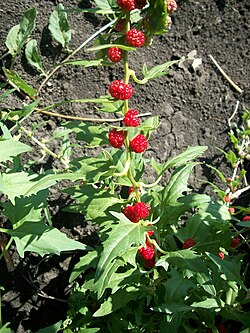This article includes a list of general references, but it lacks sufficient corresponding inline citations .(March 2013) |
| Blitum virgatum | |
|---|---|
 | |
| Scientific classification | |
| Kingdom: | Plantae |
| Clade: | Tracheophytes |
| Clade: | Angiosperms |
| Clade: | Eudicots |
| Order: | Caryophyllales |
| Family: | Amaranthaceae |
| Genus: | Blitum |
| Species: | B. virgatum |
| Binomial name | |
| Blitum virgatum | |
| Synonyms | |
| |
Blitum virgatum, [1] (syn. Chenopodium foliosum) is a species of flowering plant in the amaranth family known by the common name leafy goosefoot. It is native to Eurasia. It can be found on other continents as an introduced species, growing as a minor weed in disturbed habitats and cultivated land.